Motorola Droid 3 Review - Third Time's a Charm
by Brian Klug on July 30, 2011 12:01 AM ESTDisplay - qHD RGBW 4”
The original Droid and Droid 2 famously used high quality 3.7” IPS panels, and as a result had excellent contrast and brightness. What always struck me as being a little odd with the arrangement was that the devices used the 16:9 FWVGA (854 x 480) aspect ratio instead of WVGA’s 800x480. The difference was subtle, but as a result the Motorola Droids always did seem more rectangular than most of their other Android bretheren. Since then, qHD has become the hot new high-end Android resolution, which vindicates Motorola’s by likewise being 16:9.
Aspect ratios aside, it’s interesting to me how obvious it is that qHD is the answer to the iPhone 4’s retina display. I’ve been told that the development cycle for most of these handsets is anywhere from 12 to 18 months, and look no further than your calendar and when qHD devices have started shipping to see that in action. Whatever the reason for qHD’s emergence, it’s good to have some display innovation take place.
The Droid 3 ups the size of the primary display from the 3.7” which adorned the old Motorola Droids to 4.0”, and as already noted increases effective resolution from 854x480 to 960x540. Like the Droid X2 and other new qHD Motorola phones, the Droid 3 uses a PenTile L6W RGBW subpixel matrix to achieve effective qHD resolution. I talked about RGBW in the Droid X2 review, and what it boils down to is the inclusion of a fourth white subpixel which increases light transmittance (and thus reduces required backlight power) in a lot of use cases.
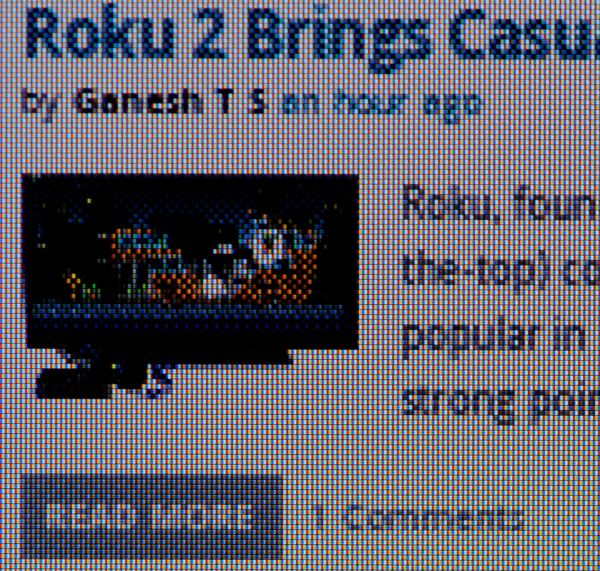

Left: Droid 3 with RGBW PenTile, Right: Droid 2 with RGB Stripe
Unlike the other RGBG PenTile which adorned AMOLED displays before Super AMOLED Plus swung around, I find RGBW much easier to stomach and completely readable when presented with black on white UIs. Colors still have visible grain, as do some UI elements, but the Droid 3’s 4” display makes this considerably less noticeable than the same resolution on the Droid X2. Only on bright colors is that extra space due to the fourth subpixel readily visible, and thanks to our color-specific visual acuity, greens are the most visible.
I immediately noticed out of the box with the Droid 3 that it wasn’t as super bright as the Droid X2, which was itself almost shockingly bright. That said, the Droid 3 is no slouch and is likewise nice and contrasty as well.
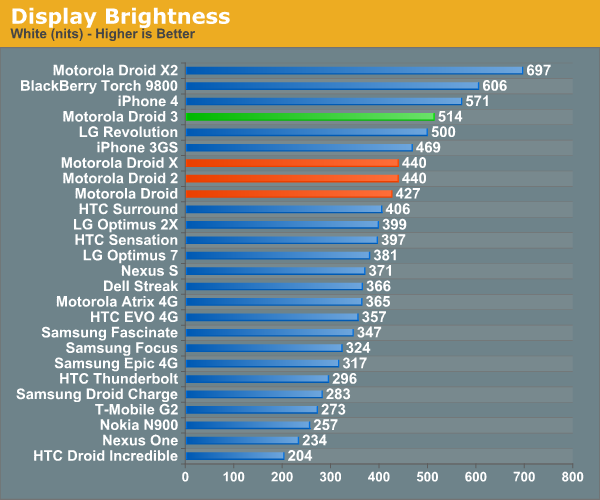
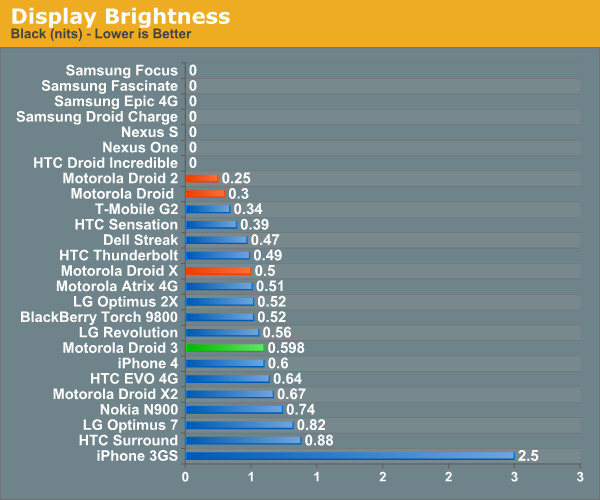

We’re still making plots of brightness (white and black), and white point at 25% brightness steps. The Droid 3’s white point tracking is slightly different from the X2’s despite also using RGBW. It ends up not being visibly blue like some of the AMOLED variants nor noticeably warm like some of the earlier Droid panels were in odd batches.

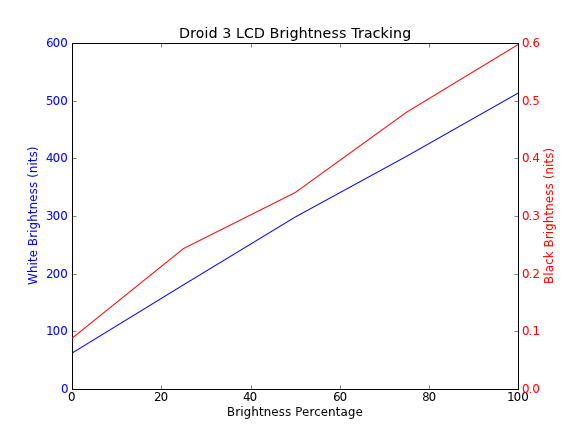
The next are of concern are viewing angles, which in my opinion the Droid 3 does very well at. I stuck the Droid 3 next to the Droid 2 and shot some pics of it at different angles. It’s surprising to me in retrospect how much color shift and contrast reduction there is in the old Droid 2 by comparison. In this regard, the Droid 3’s display is a clear step forwards.
Outdoor viewing angles are decent on the Droid 3 are pretty good but not totally perfect. RGBW helps keep brightness punchy but in my mind outdoor viewing remains an unsolved problem for just about everyone.








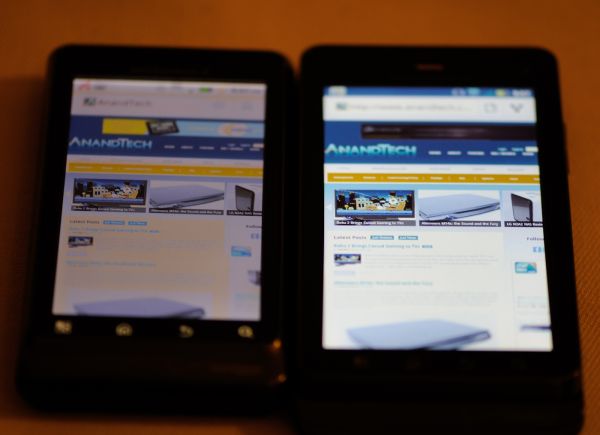
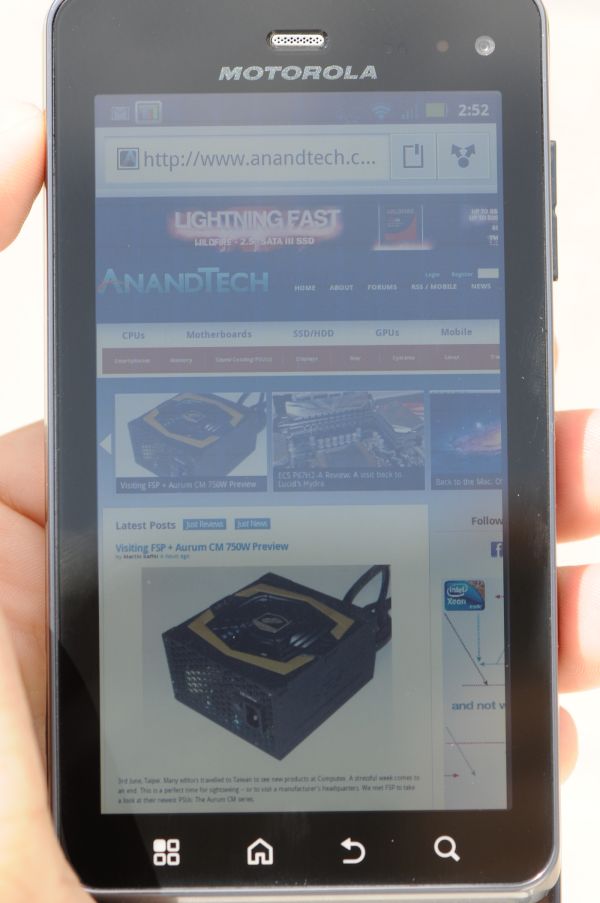








84 Comments
View All Comments
Brian Klug - Sunday, July 31, 2011 - link
Anand is still working on it, he's been super busy but hopefully it's next in his pipeline. ;)-Brian
vision33r - Sunday, July 31, 2011 - link
Using a gimmick technology to upsize the resolution cheaply. Having used the Atrix for almost 6 months I am sick of looking at it. Luckily it was for work.Looking at Pentile LCD for a long time is almost like watching a 3D movie without the glasses on. Your vision starts to strain and you will see the colors around the font.
FAIL/.
kesh27 - Sunday, July 31, 2011 - link
Seems like a lot of negativity toward the type of display. I have a D2G I like a lot and will likely upgrade to this or something very close months down the road. Sweet the D3 doesn't require a fork and incorporates global use (minus the US carrier lockout).Perhaps a little more subjective review of the new display, such as fatigue or annoyance after watching 30m of video or continuous use of a variety of apps? Maybe a small panel review of something similar to balance opinion?
As to hackability, I bought a G1 when they first came out and had it strung out on Cyanogen as far as hardware could take it, only because OTA updates weren't every coming from T-Mo. Finally got a global phone with specs I wanted for future travel. Have honestly had no need to do any hacking other than a root for Titanium Backup (freezing bloatware), ok maybe occasional wifi tether too. If you want a phone to hack, get a hackable phone. I like this line because it runs everything I want very well, and keyboards rule.
synaesthetic - Sunday, July 31, 2011 - link
Man, screw you Moto. Bunch of effin' liars.UNLOCK IT NAO. And the one on the Droid X2 also!
Undersea - Sunday, July 31, 2011 - link
Might be silly to some but coming from blackberry which I could sort email to droid 1 which I couldn't, I hope to heck you can sort outlook emailhillsurfer - Monday, August 1, 2011 - link
We just upgraded my wife's line to the Droid 3, and the fact that it isn't LTE is one reason we chose it. We still have the unlimited 3G data plan, which we'd have to give up if we switched to LTE, which isn't available in this area anyway, and won't be for some time.Just wanted to point out that some "improvements" come with a price. Luckily, Motorola and Verizon Wireless didn't include LTE as an improvement. I suspect we won't have that choice much longer.
funoptics - Monday, August 1, 2011 - link
Great review, AnandTech! It could be top notch, however, if you included the only thing that seemed to be missing: a discussion of the performance and capabilities of the motion sensors. Some smart phones have gyros, the Droid 3 does not. For users of smartphones working with augmented reality applications, this is very important.photoguru - Monday, August 1, 2011 - link
One thing that most people have overlooked is the fact that they put a 16GB card hardwired in it and also gave us a card slot for a second card! I loaded mine up with 48GB of class 10 storage goodness :)nitink - Monday, August 1, 2011 - link
this phone have a great potential unleach its power get full hd games with sd card data..at:http://nitin-xyz.blogspot.com/2011/07/free-and-ful...
araczynski - Monday, August 1, 2011 - link
I had the first droid for about a year when it first came out, found the keyboard sliding mechanism to be a joke. poorly engineered, namely due to easily trapping dust/fine particles of sand (or gold;)), and the rail mechanism just wearing away at the back surface, making it look cheap and abused after only a few uses.would never use another phone that uses the same engineering, which this seems to be just like.
i like my droid x at the moment, much nicer screen, and i'll take the onscreen keyboard over worthless sliding any day.